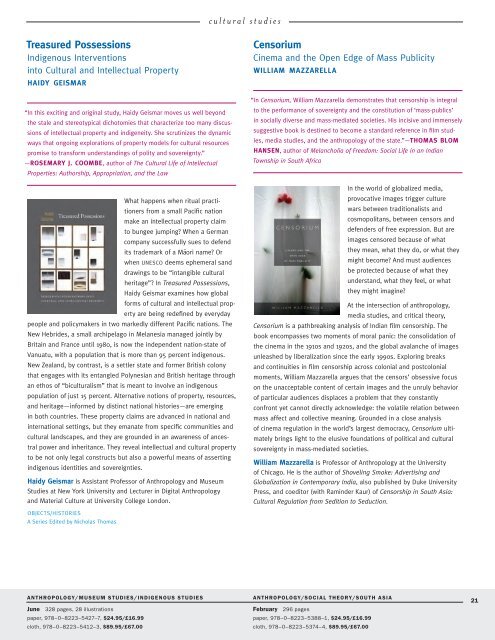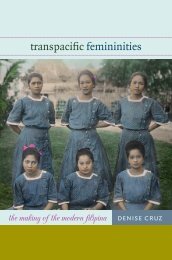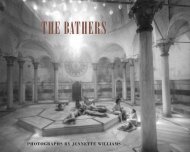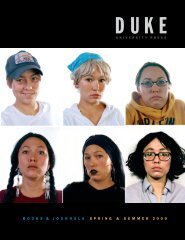Spring 2013 Catalog - Duke University Press
Spring 2013 Catalog - Duke University Press
Spring 2013 Catalog - Duke University Press
Create successful ePaper yourself
Turn your PDF publications into a flip-book with our unique Google optimized e-Paper software.
Treasured Possessions<br />
Indigenous Interventions<br />
into Cultural and Intellectual Property<br />
haidy geismar<br />
“In this exciting and original study, Haidy Geismar moves us well beyond<br />
the stale and stereotypical dichotomies that characterize too many discus-<br />
sions of intellectual property and indigeneity. She scrutinizes the dynamic<br />
ways that ongoing explorations of property models for cultural resources<br />
promise to transform understandings of polity and sovereignty.”<br />
—ROSEMARY J. COOMBE, author of The Cultural Life of Intellectual<br />
Properties: Authorship, Appropriation, and the Law<br />
ANTHROPOLOGY/MUSEUM STUDIES/INDIGENOUS STUDIES<br />
June 328 pages, 28 illustrations<br />
paper, 978–0–8223–5427–7, $24.95/£16.99<br />
cloth, 978–0–8223–5412–3, $89.95/£67.00<br />
What happens when ritual practi-<br />
tioners from a small Pacific nation<br />
make an intellectual property claim<br />
to bungee jumping? When a German<br />
company successfully sues to defend<br />
its trademark of a Māori name? Or<br />
when UNESCO deems ephemeral sand<br />
drawings to be “intangible cultural<br />
heritage”? In Treasured Possessions,<br />
Haidy Geismar examines how global<br />
forms of cultural and intellectual prop-<br />
erty are being redefined by everyday<br />
people and policymakers in two markedly different Pacific nations. The<br />
New Hebrides, a small archipelago in Melanesia managed jointly by<br />
Britain and France until 1980, is now the independent nation-state of<br />
Vanuatu, with a population that is more than 95 percent indigenous.<br />
New Zealand, by contrast, is a settler state and former British colony<br />
that engages with its entangled Polynesian and British heritage through<br />
an ethos of “biculturalism” that is meant to involve an indigenous<br />
population of just 15 percent. Alternative notions of property, resources,<br />
and heritage—informed by distinct national histories—are emerging<br />
in both countries. These property claims are advanced in national and<br />
international settings, but they emanate from specific communities and<br />
cultural landscapes, and they are grounded in an awareness of ancestral<br />
power and inheritance. They reveal intellectual and cultural property<br />
to be not only legal constructs but also a powerful means of asserting<br />
indigenous identities and sovereignties.<br />
Haidy Geismar is Assistant Professor of Anthropology and Museum<br />
Studies at New York <strong>University</strong> and Lecturer in Digital Anthropology<br />
and Material Culture at <strong>University</strong> College London.<br />
OBJECTS/HISTORIES<br />
A Series Edited by Nicholas Thomas<br />
cultural studies<br />
Censorium<br />
Cinema and the Open Edge of Mass Publicity<br />
william mazzarella<br />
“In Censorium, William Mazzarella demonstrates that censorship is integral<br />
to the performance of sovereignty and the constitution of ‘mass-publics’<br />
in socially diverse and mass-mediated societies. His incisive and immensely<br />
suggestive book is destined to become a standard reference in film studies,<br />
media studies, and the anthropology of the state.”—THOMAS BLOM<br />
HANSEN, author of Melancholia of Freedom: Social Life in an Indian<br />
Township in South Africa<br />
ANTHROPOLOGY/SOCIAL THEORY/SOUTH ASIA<br />
February 296 pages<br />
paper, 978–0–8223–5388–1, $24.95/£16.99<br />
cloth, 978–0–8223–5374–4, $89.95/£67.00<br />
In the world of globalized media,<br />
provocative images trigger culture<br />
wars between traditionalists and<br />
cosmopolitans, between censors and<br />
defenders of free expression. But are<br />
images censored because of what<br />
they mean, what they do, or what they<br />
might become? And must audiences<br />
be protected because of what they<br />
understand, what they feel, or what<br />
they might imagine?<br />
At the intersection of anthropology,<br />
media studies, and critical theory,<br />
Censorium is a pathbreaking analysis of Indian film censorship. The<br />
book encompasses two moments of moral panic: the consolidation of<br />
the cinema in the 1910s and 1920s, and the global avalanche of images<br />
unleashed by liberalization since the early 1990s. Exploring breaks<br />
and continuities in film censorship across colonial and postcolonial<br />
moments, William Mazzarella argues that the censors’ obsessive focus<br />
on the unacceptable content of certain images and the unruly behavior<br />
of particular audiences displaces a problem that they constantly<br />
confront yet cannot directly acknowledge: the volatile relation between<br />
mass affect and collective meaning. Grounded in a close analysis<br />
of cinema regulation in the world’s largest democracy, Censorium ultimately<br />
brings light to the elusive foundations of political and cultural<br />
sovereignty in mass-mediated societies.<br />
William Mazzarella is Professor of Anthropology at the <strong>University</strong><br />
of Chicago. He is the author of Shoveling Smoke: Advertising and<br />
Globalization in Contemporary India, also published by <strong>Duke</strong> <strong>University</strong><br />
<strong>Press</strong>, and coeditor (with Raminder Kaur) of Censorship in South Asia:<br />
Cultural Regulation from Sedition to Seduction.<br />
21












